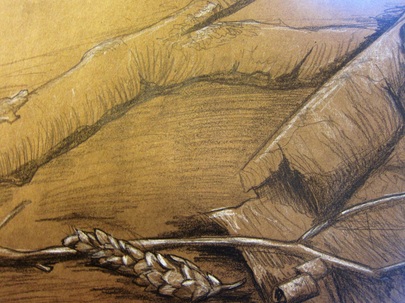|
3/1/2012 10 Comments The Harvard ForestI spent a week during the past January break at the Harvard Forest, located in Petersham, Massachusetts, writing, drawing, exploring, and discussing ecology with nine other Harvard students as well as Harvard professors. Called Reading and Conserving New England, this optional Jterm activity was an incredible way to experience the life of an ecologist, a nature artist, a conservationist, and a poet, all in one, too-short week. Here is a piece that I wrote after being part of an expedition into the Black Gum Swamp, crusted over with frost and snow on that wintry January day. We were on a mission to collect a sediment core and examine the history of the swamp by literally extracting a sample of earth out of the ground. Dig Deeper
It is called Black Gum Swamp because the tree within stands taller and stouter than the rest, the black gum that is three hundred years old. Yet, hiding underneath is a history unimaginable. A history to hold, to feel like grasping clay, silty and smooth, molded, to taste as sand, grainy and metallic, to see as leaves and twigs, fibrous netting, to smell in all its glory, heart-mud found deep, deep down. A few days ago, I dug beyond the Earth’s skin of snow. I dug into a winding circulatory system of roots, resting in layers and layers of sediment, some soft as fat, others dense and muscular. I dug through thousands of years of organic debris. That afternoon, hands grasping at cold metal rods, I made my way to the melted spot, crunching along the frozen swamp, the black gum tree beside me standing tall, bark like puzzle pieces. Finding it, an opening in the ice, I took a breath and plunged the metal blade in, using the handle bars to press it through the swamp muck. The sky and its clouds watched as I dug through five hundred years of Earth. Pulling the rod up, a gush of dark water rose and gurgled to the surface. I opened the shovel at the end of the metal pole and extracted a fifty-centimeter core of sediment, composed of small decomposing leaves, orange-brown, bits of root, spongy twigs, flecks of black charcoal. I opened up the Earth and slid her into a robe of aluminum foil. I went down further still, down, down to three-thousand, seven-thousand, twelve-thousand years. I struck hard for each core and once extracted, wrapped it lovingly with foil. Under a microscope, I warmed my hands and watched two-centimeter pieces of rotting wood float amidst sedge strands and mulch. I witnessed the spindly stems of lake moss undulate, moss that came from a time not long after glaciers in New England had melted. These stems had not seen air, not seen sun, not seen surface until now. Until a metal shovel hit twelve thousands years of Earth, the lake that held this moss had been forgotten, filled up to become a pasture which moistened and became wetland which, filled with more water, became a swamp, this swamp now, this swamp full of trees and vegetation. I witnessed an Earth, unknown until now, under the microscope. Digging deep, deep, deeper. There’s a sense of adventure and wisdom in those words, a confidence in knowing that the surface is only just that, in knowing the wisdom of the view above treetops, the secrets underneath the shore, an urging, a calling. Go, dig deep. Not just tiptoeing lightly, brushing at the top of things, allowing glimpses here and there. Do not settle for small talk, for the flippancy of shallow relationships with the world around us, the Earth below us. Long to know more, to get on hands and knees and dig for that root connection. Do not be afraid to leave behind a mess of bog sludge and black muck. Do not be nervous of what can be found below the surface. Dig deep. Yes, deeper than even that.
10 Comments
9/10/2012 03:55:57 am
Wow, wow, wow! I wish I was a great writer like you, because trust me I am falling short off words to express what I am feeling after reading this blog post. I really appreciate your skills and thoughtfulness.
Reply
9/17/2012 02:09:21 am
Pretty cool post. It’s really very nice and useful post. Thanks for sharing this with us!it’s my first visit.
Reply
9/18/2012 03:02:45 am
I like the precious suggestions you shared with us in your expertly written blog post. I want to thank you for this. Nice work.
Reply
9/23/2012 02:08:06 am
I admire the valuable advice you make available in your expertly written content. I want to thank you for this informative read; I really appreciate sharing this great.
Reply
9/30/2012 09:01:41 pm
Nice to be visiting your blog again about The Harvard Forest, it has been months for me. Well this article that i've been waited for so long. I need this article to complete my assignment in the college, and it has same topic with your article. Thanks, great share.
Reply
2/12/2022 07:54:24 am
thanks for sharing the informative blog.
Reply
Leave a Reply. |
What's HotGet the DigestAbout the Blogger
Stephanie M. Wang is a Chemical and Physical Biology major at Harvard College, Class of 2013. She is a pre-med who just can't get enough of the hard sciences. She loves learning new things, frisbee, poetry, every kind of apple, people. Stephanie blogs regularly for the Scientista Foundation: Find her blog here!
More From Stephanie |
The Network for Pre-Professional Women in Science and Engineering
The Scientista Foundation is a registered 501(c)(3) -- Donate!







 RSS Feed
RSS Feed